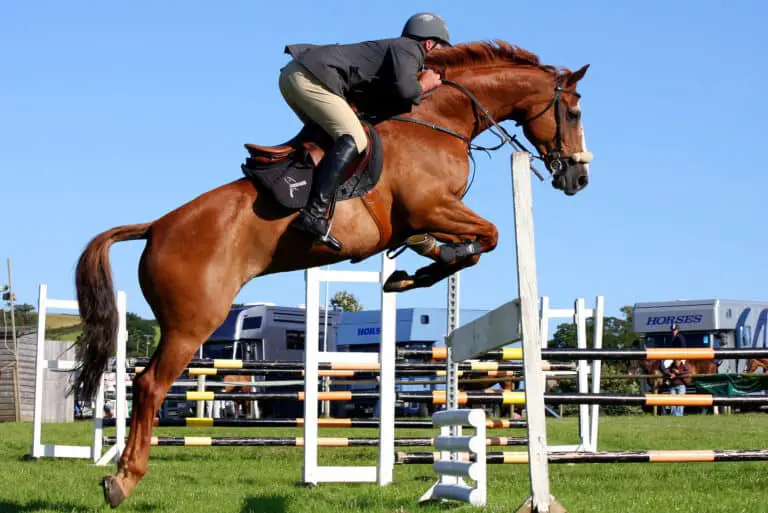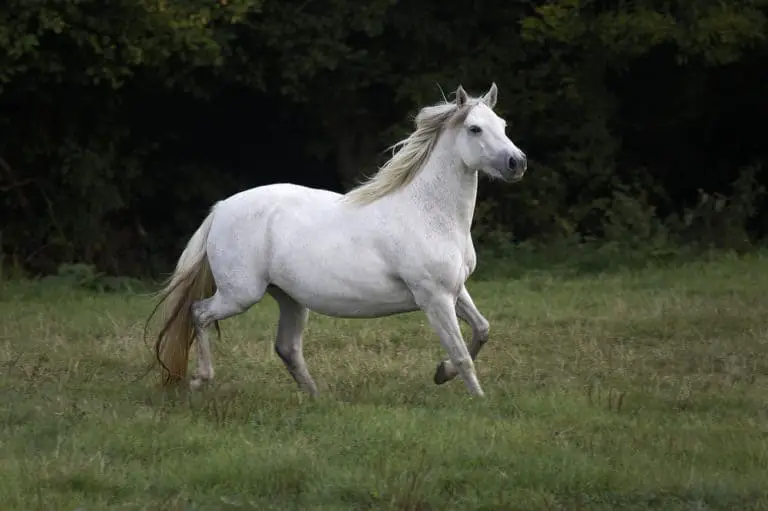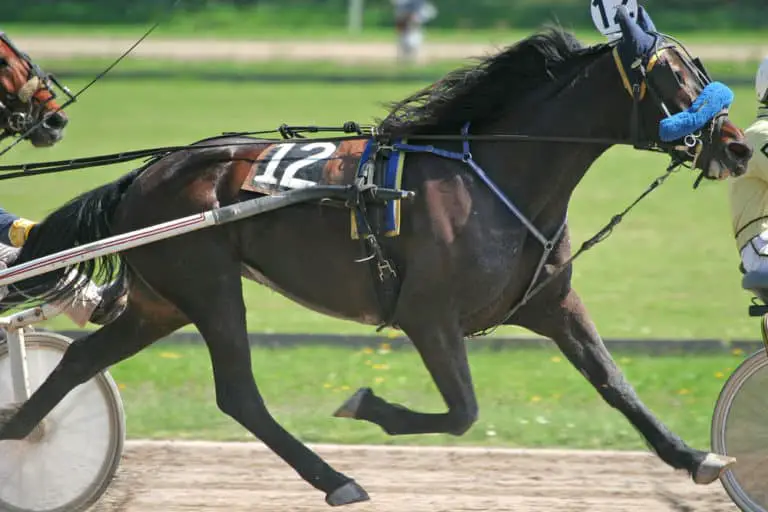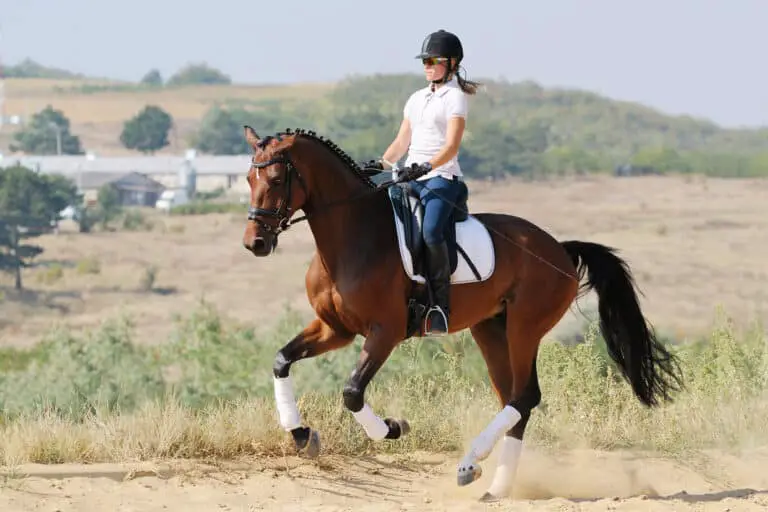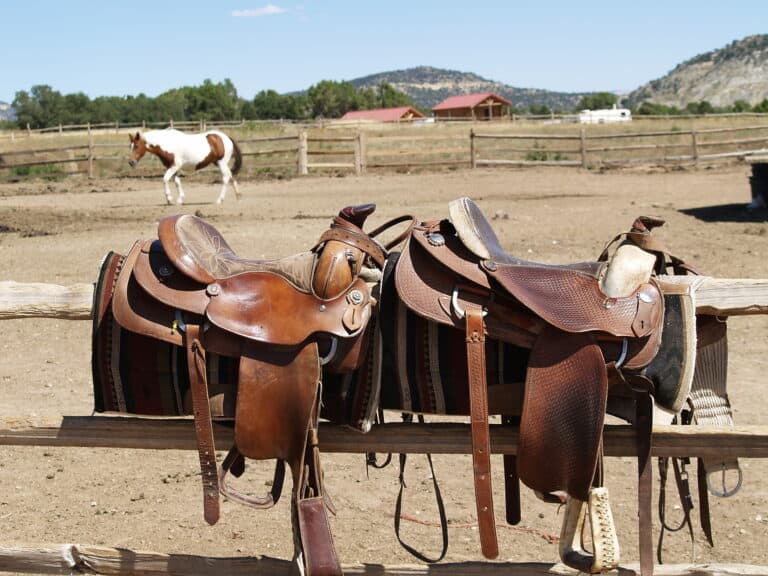Black Forest Horse: Care, Cost & History (2024)

The Black Forest horse is a light draft breed that developed in the Black Forest region of southwest Germany.
They were originally used for forestry and agricultural work, and are also popular for pleasure riding and driving horses because of their long, sure-footed strides and their good-natured temperaments. Unfortunately, they are rare but are protected by dedicated breeders.
Breed: Black Forest horse
Adult Weight: 1,100-1,300 pounds
Adult Height: 14.2-15.3 hands (58-63 inches)
Origin: Germany
Use: Pleasure riding and driving, agricultural work
Colors: Chestnut and dark chestnut with a flaxen mane and tail
Features: Expressive eyes, muscular hindquarters
Lifespan: 18-20 years
Character: Good-natured and friendly
Gait: Long, elegant strides; sure-footed
Best for: All levels of riders
- Characteristics
- Black Forest horse Care
- Black Forest horse History
- Modern Black Forest horse
- Cost and Ownership
- Buying a Black Forest horse
- Similar Breeds
Black Forest Horse Characteristics
The Black Forest horse head is short with large, expressive eyes. They have a strong neck that ties into a sloping shoulder and a medium-sized and muscular body and hindquarters. Their legs are strong with clean joints and hard hooves. The Black Forest horse characteristics give them long, elegant strides and sure-footedness in any terrain.
Size
Black Forest horse height is between 14.2 and 15.3 hands tall or 58 to 63 inches. Males are taller than mares, with the stallions reaching up to 15.3 hands. The mares range from 14.2 to 15.1 hands. (1)
The Black Forest foal will be 82% of its mature height at six months of age and is 97% of its full height by the time they are two years old.
Black Forest horse size is considered medium among all horse breeds. This structure and size make them athletic, and it’s easier for them to maneuver in forests and agricultural fields, where they originally worked.
Weight
The bone structure in the Black Forest breed supports a medium-sized, light draft horse. The bones are larger in size, with clean lines and joints. These support the broad and muscular hindquarters that make them very powerful.
Black Forest horse weight ranges from 1,100 to 1,300 pounds, with males being slightly heavier than females.
Foals weigh between 110 and 130 pounds at birth. They are at 90% of their mature weight by 22 months of age, just under two years old. Horses are fully mature by four or five years of age in height and weight, but most growth is in the first two years.
Colors
The primary Black Forest horse colors are chestnut and dark chestnut, with a flaxen mane and tail. Flaxen is a genetic breed trait where the mane and tail are lighter colors than the chestnut body, creating a distinct appearance in the beautiful Black Forest horse.
Therefore, horses appear a varying red chestnut color with what looks like a white mane and tail, although chestnut hairs can be in the mane and tail too.
Bay and gray are rare Black Forest horse colors. Research was conducted on 250 horses to determine the prevalence of the silver coat color gene in the breed. It was determined that out-crossing to other breeds caused this mutation, so it is also rare. (2)
Temperament
The Black Forest horse temperament is described by all who know and own them as good-natured and friendly. Horses are people-oriented and enjoy their work.
This makes them an appropriate breed for equestrians at all levels, from beginner to experienced. Many enjoy them as family horses and also note that they are sensible in any situation.
The breed is very powerful because of its strong hindquarters. This characteristic, combined with their Black Forest horse behavior, makes them durable as a workhorse or for recreation.
The Black Forest horse uses the general rules of the United States Equestrian Federation when competing. This means that children aren’t allowed to exhibit stallions. (3)
Black Forest Horse Care
The Black Forest horse breed is easy to care for because of its wonderful temperament and durable bodies. They require a basic level of care that any animal does – food, water, shelter, veterinary, and hoof care. If these needs are met, the Black Forest horse lifespan is 18 to 20 years.
Diet and Nutrition
Diet and nutrition are essential to horse care. Black Forest horses are larger than regular-sized horses and therefore eat more. Those in heavier work – either agricultural or forestry work or regular recreation riding and driving, will also require more feed. (4)
The Black Forest horse diet consists of forage – hay and grass, as well as concentrates or grains, vitamin, and mineral supplements. Water is a mainstay and the most important nutrient in any diet. (5)
The amount of grain and supplements needed is determined by the quality and nutritional matter in the hay and grass as well as the level of work. An equine nutritional professional can help determine dietary needs. (5)
Health Problems
The Black Forest cold-blooded horse doesn’t have many health problems as long as its basic healthcare needs are met. This starts with proper diet and nutrition and continues with regular veterinary, dental, and hoof care. (6)
Owners can maintain the good health of their horses by keeping them up to date on veterinary care and hoof trimming and feeding them a balanced diet. Maintaining a healthy weight through diet and exercise also helps prevent health problems. (6)
The breed currently doesn’t have any known genetic problems, however, the small population size could lead to future issues. Research studying the effects of inbreeding on the Black Forest horse is ongoing, and if it continues increasing, could lead to future problems. (7)
Grooming
Black Forest horse grooming is one way that the horse and owner can bond with each other, and it also helps keep the horse healthy by checking for any issues. Many consider grooming to be a part of health care, especially when it comes to cleaning the horses’ hooves. This should be done daily to prevent any problems. (6)
The beautiful mane and tail of the Black Forest horse is a distinguishing breed characteristic, and careful grooming of this help preserve the horse’s beauty. The mane and tail should be washed to enhance the flaxen color and carefully picked out regularly to prevent hair breakage. (8)
Black Forest Horse History
Black Forest horse history dates back to the 1400s when their presence was first recorded at an Abbey in the Black Forest region. They continued being bred and used in the region, and the first breed organization was formed in 1896. They also have a lively history that includes secret breeding and forged pedigrees.
Origin
The Black Forest breed is over 600 years old and originated in the same region of Germany. Black Forest horse origin includes the Noriker horse and other native horses of the region.
The Schwarzwälder Kaltblut horse, the German name for the breed, owes much of its early development to the Abbey of Saint Peter in the Black Forest region of the country. This is a Benedictine monastery where the horses were bred, and they were the first to mention the breed in their records from the 1400s.
Black Forest horses were bred for agricultural and forestry work in the mountains and hilly areas of the region, as well as transportation.
Historic Development
Historic development of the breed has relied upon a host of people from Germany, from the monasteries in the region who started the record-keeping to the farmers that used the breed in the 1800s and early 1900s who were also responsible for maintaining it.
The breed suffered serious setbacks with mechanization, and this caused population numbers to drop. The Nazi period caused the studbook to be merged in 1935 with the Baden studbook. Then, the French re-started the joint studbook after the war.
In 1990, the Schwarzwälder Pferdezuchtgenossenschaft breed association was re-started and has been working since to re-develop the breed and build the population back up from its endangered status.
Notable Black Forest Horses
The famous Black Forest horses include many modern horses that are impacting the breed by carrying on the Black Forest horse pedigree. Because they are still endangered, breeding is one of the ways these horses currently become notable. Of course, none of this would be possible without the famous horses that came before them.
Retter
Retter was a beautiful dark chestnut Black Forest stallion born in 1977. Through the different performance tests, he reached Elite Horse status, which is the highest a horse can receive. Retter was sired by Remig and his maternal sire was Militar. He sired over 68 offspring and his influence is still felt in the breed.
Remo
Remo was a son of Retter, born in 1994, and state-approved and performance tested. He was imported to Canada and owned by Schwarzwälder Füchse / Black Forest Horse Stud Farm, the first in North America. He was known for his good manners, beautiful movement and looks, and athleticism, all traits passed onto his offspring.
Franceska
We cannot forget the importance of the mares. Franceska is a 2009 chestnut by Faroe, and out of a mare named Ramona. Her dam, Ramona, was the first Black Forest mare imported to the United States, and Franceska is breeding those lines on and helping promote the breed in the United States, especially their willingness to work and personalities.
Myths and Legends
Breeds with hundreds of years of history also have intriguing stories. There are many Black Forest horse legends, but one of the most interesting is how farmers persevered in breeding the horse they knew to be best for their work. Newer legends include the breed’s appearance in modern-day video games, increasing their popularity.
Secret Breeding Operations
A breed association was established in the Black Forest region in 1896 and farmers were told they could only use Belgian draft horses. But, they thought their native horses were more appropriate for agricultural work in the area and secretly used them. Many horses were born and had forged papers during this time.
The Government Catches Up
The farmers didn’t want to use the Belgians because the region is so hilly, and their native Noriker horses were bred to navigate the highlands. The government finally caught up with the farmers after World War I and realized the Belgian wasn’t suitable for farm work here and told the farmers they could breed whichever horses they wanted.
Gamers
The Black Forest horse is one of the breeds available to gamers in the Horse Legends game, where people can build their own stable and show string. The horses are recommended for use in the game for driving, showing in halter, or pulling. The game also includes two rare Black Horse colors that gamers try to find.
Modern Black Forest Horses
There are six types of Black Forest horses today, all aligned with different bloodlines. All have a similar phenotype, meaning appearance-wise, all bloodlines align with the breed standard and look similar to each other. Most horses are proficient in riding, driving, or both, and their area of excellence is more a factor of their Black Forest horse training.
Breeding
Black Forest horse breeding primarily occurs in Germany still, however, a farm imported horses to Canada and helped the breed start in North America. This led to a small population of Black Forest horses in the United States as well.
The six bloodlines available are the D-Line, M-Line, R-Line, W-Line, F-Line, and V-Line. Of these, the M-Line is the oldest. Retter and Remo are both from the R-Line.
Noriker horses were introduced (a combination of the R and W lines) to help eliminate line breeding. The F-Line and V-Line also resulted from introducing outside bloodlines to eliminate line breeding and future health problems.
Population
The Black Forest horse population is about 1,200 horses worldwide, including the population in the United States and Canada, with most horses in Germany. (9) Population in the United States is only about 23 horses. (10) The Food and Agricultural Organization listed them as endangered in 2007 and they remain on that list. (11)
Forty-six stallions are approved by the breed association, and 16 of these stand at Marbach, the state-owned stud farm. There are also approximately 700 registered mares in Germany. (12)
The breed’s endangered status means it’s harder to find a Black Forest gelding since stallions are usually retained for breeding. Most available geldings are located in Germany.
Uses
In some areas, the Black Forest horse uses are still for light agricultural work or forestry, in areas where it’s hard to maneuver tractors and equipment. These traditional uses have largely been replaced by showing and recreational riding and driving.
Performance tests for the breed registry do still include pulling and driving, and horses excel in these disciplines.
The Black Forest horse gait is expansive, it has a long stride and fluid motion that is round and looks like they float across the ground effortlessly. People enjoy riding them in dressage competitions, for pleasure, and on the trails. Driving is done in both competitions and for fun.
Black Forest Horse Prices
Owning a horse is an expensive endeavor because of the care and upkeep the horse requires, but it’s also rewarding. The Black Forest horse price includes the initial purchase and then board, feed, and other costs for each year the horse is owned. This can add up to a significant expense each year and throughout horse ownership.
Purchase Price
The price of Black Forest horse is around $9,500 and oftentimes more because they are a rare breed. (13) It can be difficult to find one for sale because the population is small, and many horses are sold under private contracts.
These factors make the Black Forest horse an expensive breed to purchase. More foals are being born though, thanks to dedicated breeders. Those with mares also invest to bring new Black Forest horses into the world.
Stud fees for the Black Forest horse range between 300 and 400 Euros at the Marbach Stud Farm, depending on the status of the stallion. (14)
Ownership Costs
Black Forest horse price is just the first expense in horse ownership. Next come the monthly and annual bills for the board, or the stable and pasture for the horse, feed, veterinary attention, and hoof trimming and shoes. These expenses combined are the Black Forest horse ownership cost and are $1,770 to $12,930 each year.
Board
Black Forest horse board cost is one of the larger expenses each year and costs $1,200 to $7,200 per year. It’s a larger price range because of the vast differences in the types of boarding facilities available, from simple run-in sheds in pastures to finely appointed barns with indoor arenas. (15)
Feed
The second most expensive aspect of horse ownership is annual feed costs. These are the hay, grain, and nutritional supplements the horse requires. The Black Forest horse feed cost is between $250 and $4,380 each year, depending on the amount of grass available and again, geography influences the cost and availability of hay. (15)
Veterinary Care
Black Forest horse veterinary cost is essential to maintaining the horse’s health and well-being and costs between $250 and $350 each year. An accident or injury can add an additional $1,000 to this price. Routine veterinary care includes vaccines, deworming, and dental care. If these are skipped it can lead to even costlier problems in the future. (15)
Hoof Care
Horses’ hooves grow non-stop, the same way people’s fingernails do. A farrier trims them every six to eight weeks to help the horse stay equally balanced on all four feet and sound. The Black Forest horse hoof care cost is between $120 and $1,000 annually. Horses that require shoes will be on the upper end of that range. (15)
Buying a Black Forest Horse
Buying a Black Forest horse is not as simple as with some other breeds, but it’s just as rewarding. There are fewer horses to choose from, but the Black Forest horse breed is friendly, beautiful, and athletic. Scarcity makes some buyers jump at the first horse available, but make sure you wait and find a horse you really enjoy.
Is the Black Forest Horse Right for You?
Owning a Black Forest horse is the right decision for you if you want to help preserve and grow a rare breed of horse, enjoy owning a beautiful horse, and like to ride and/or drive horses in competition and for fun.
Riding a Black Forest horse brings out huge smiles in people because of the large and smooth strides, their untiring endurance, and their friendly personality. These traits mean that riders at all levels can enjoy the breed.
The number of horses used for agricultural work and forestry has declined, but these horses are just as talented as they were before.
How to Buy a Black Forest Horse?
Buying a Black Forest horse will feel a bit like searching for a needle in a haystack but it’s actually easier than most people think. Since there are so few horses in the world, it’s a bit easier to identify people that have horses for sale.
Reach out to a Black Forest breeder and ask about their stock, and any they know of for sale in other areas. Make sure that you ride or drive the horse (if it’s mature and trained) before purchasing it to ensure it does those things you intend to do once you own the horse. If purchasing a foal or young horse, ask about the parents and their strengths and weaknesses.
Similar Breeds to Black Forest
There are some Black Forest breed alternatives that can be considered since the horses are rare. The Haflinger is a similar light draft breed from Austria that is also usually a chestnut with a friendly personality. The Noriker played a critical role in the breed’s development. Norwegian Fjords are another popular light draft breed used for riding and driving.
Haflinger
The Haflinger is a light draft horse breed that developed in Austria and northern Italy. They have a light chestnut body with a flaxen mane and tail. Haflingers are sure-footed, muscular, and elegant horses with smooth, distinct gaits. As the Black Forest horse, they are popular for light draft work and recreational riding and driving.
Noriker
The Noriker horse breed developed in Austria and factors heavily into the development and current status of the Black Forest horse breed. Norikers developed in the Alps and as a draft breed, are known for their sure-footedness and ease with the terrain. They have many more colors than the Black Forest Horse, including leopard spots.
Norwegian Fjord
The Norwegian Fjord breed is a light draft horse. They developed in the mountains of western Norway and have a light dun coat and dark dorsal stripe that is more visible because their manes are roached. The Fjord horse is strong, muscular, and agile. It has a small body and a friendly personality.
FAQ
What is a Black Forest horse?
The Black Forest horse is a light draft breed that originated n the Black Forest region of Germany for work in agriculture and forestry.
What does a Black Forest horse look like?
The Black Forest horse is chestnut or dark chestnut with a flaxen mane and tail. They are muscular horses with large, expressive eyes.
How did the Black Forest horse get its name?
The Black Forest horse is named for the Black Forest in Germany where the breed originated.
Can you ride a Black Forest horse?
Yes, the Black Forest horse is an excellent riding horse for all levels of riders.
Are Black Forest horses good for beginners?
The Black Forest is a friendly and good-natured horse that is good for beginners.
How tall is a Black Forest horse?
A Black Forest horse is between 14.2 and 15.3 hands tall or 58 to 63 inches.
How much does a Black Forest horse weigh?
The Black Forest horse weighs between 1,100 and 1,300 pounds.
How big is a Black Forest horse?
A Black Forest horse is an average height with a muscular body that makes them look big.
How much does a Black Forest horse cost?
The Black Forest horse is rare and a limited number are for sale; prices are often by private contract. Expect to pay over $9,500.
How much does a Black Forest horse ownership cost?
Black Forest horse ownership costs between $1,770 to $12,930 every year.
How long do Black Forest horses live?
Black Forest horses live for 18 to 20 years.
How fast can a Black Forest horse run?
The Black Forest horse can run 27 miles per hour.
How much can a Black Forest horse pull?
A Black Forest horse can pull between 1,650 and 1,950 pounds.
How much can a Black Forest horse carry?
A Black Forest horse can carry between 220 and 260 pounds.
At what age is a Black Forest horse full grown?
A Black Forest horse is full-grown between the ages of four and five.
What are Black Forest horses used for?
Black Forest horses are used for agricultural and forestry work, as well as pleasure riding and driving.
References
- Schwarzwälder Pferdezuchtgenossenschaft. 2022. Das Schwarzwälder Kaltblutpferd (St. Märgener Fuchs). Link
- Stefanie Lehner, Rahel Schrimpf, Claudia Dierks, Ottmar Distl. 2013. Incidence of Mutation for Silver Coat Color in Black Forest Horses. Link
- United States Equestrian Federation. 2022. Licensed Competitions. Link
- Nanaji Deshmukh Veterinary Science University Jabalpur. 2022. Feeding of Horses. Link
- Merck Vet Manual. 2021. Nutritional Requirements of Horses and Other Equids. Link
- Merck Vet Manual. 2016. Routine Health Care of Horses. Link
- Maarit Müller-Unterberg, Sandra Wallmann, Ottmar Distl. 2017. Effects of inbreeding and other systematic effects on fertility of Black Forest Draught horses in Germany. Link
- United States Equestrian Federation. 2019. Pro Tip: Mane and Tail Care. Link
- Schwarzwälder Pferdezuchtgenossenschaft. 2022. Stutbuchaufnahmen der Schwarzwälder Kaltblutstuten 2022. Link
- Cielo Celeste Farms. 2022. Black Forest Mares. Link
- European Commission. 2022. Additional tools On-farm conservation of rare and endangered local animal breeds – EU. Link
- Black Forest Horses. 2022. Schwarzwälder Füchse – Black Forest Horses. Link
- Schwarzwälder Pferdezuchtgenossenschaft. 2022. Angebote & Kleinanzeigen. Link
- Haupt-Und Landgesüt Marbach. 2022. Draft horse stallions. Link
- Arabian Horse Association. 2022. What is the Cost of Providing for Them? Link

